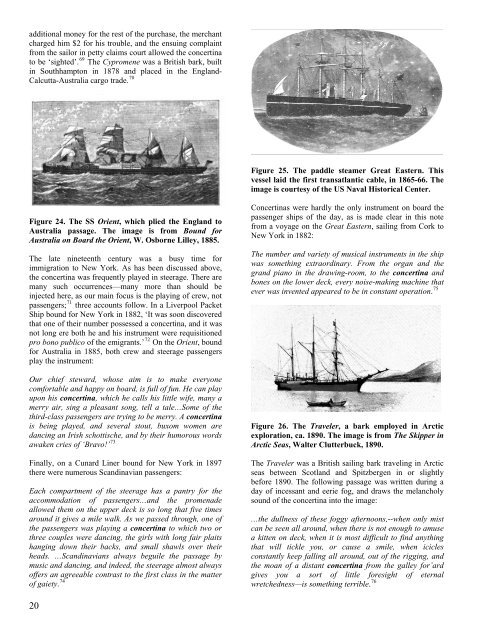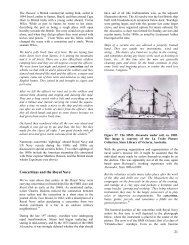The Concertina at Sea - The Anglo-German Concertina
The Concertina at Sea - The Anglo-German Concertina
The Concertina at Sea - The Anglo-German Concertina
Create successful ePaper yourself
Turn your PDF publications into a flip-book with our unique Google optimized e-Paper software.
additional money for the rest of the purchase, the merchant<br />
charged him $2 for his trouble, and the ensuing complaint<br />
from the sailor in petty claims court allowed the concertina<br />
to be ‘sighted’. 69 <strong>The</strong> Cypromene was a British bark, built<br />
in Southhampton in 1878 and placed in the England-<br />
Calcutta-Australia cargo trade. 70<br />
Figure 24. <strong>The</strong> SS Orient, which plied the England to<br />
Australia passage. <strong>The</strong> image is from Bound for<br />
Australia on Board the Orient, W. Osborne Lilley, 1885.<br />
<strong>The</strong> l<strong>at</strong>e nineteenth century was a busy time for<br />
immigr<strong>at</strong>ion to New York. As has been discussed above,<br />
the concertina was frequently played in steerage. <strong>The</strong>re are<br />
many such occurrences—many more than should be<br />
injected here, as our main focus is the playing of crew, not<br />
passengers; 71 three accounts follow. In a Liverpool Packet<br />
Ship bound for New York in 1882, ‘It was soon discovered<br />
th<strong>at</strong> one of their number possessed a concertina, and it was<br />
not long ere both he and his instrument were requisitioned<br />
pro bono publico of the emigrants.’ 72 On the Orient, bound<br />
for Australia in 1885, both crew and steerage passengers<br />
play the instrument:<br />
Our chief steward, whose aim is to make everyone<br />
comfortable and happy on board, is full of fun. He can play<br />
upon his concertina, which he calls his little wife, many a<br />
merry air, sing a pleasant song, tell a tale…Some of the<br />
third-class passengers are trying to be merry. A concertina<br />
is being played, and several stout, buxom women are<br />
dancing an Irish schottische, and by their humorous words<br />
awaken cries of ‘Bravo!’ 73<br />
Finally, on a Cunard Liner bound for New York in 1897<br />
there were numerous Scandinavian passengers:<br />
Each compartment of the steerage has a pantry for the<br />
accommod<strong>at</strong>ion of passengers…and the promenade<br />
allowed them on the upper deck is so long th<strong>at</strong> five times<br />
around it gives a mile walk. As we passed through, one of<br />
the passengers was playing a concertina to which two or<br />
three couples were dancing, the girls with long fair plaits<br />
hanging down their backs, and small shawls over their<br />
heads. …Scandinavians always beguile the passage by<br />
music and dancing, and indeed, the steerage almost always<br />
offers an agreeable contrast to the first class in the m<strong>at</strong>ter<br />
of gaiety. 74<br />
20<br />
Figure 25. <strong>The</strong> paddle steamer Gre<strong>at</strong> Eastern. This<br />
vessel laid the first trans<strong>at</strong>lantic cable, in 1865-66. <strong>The</strong><br />
image is courtesy of the US Naval Historical Center.<br />
<strong>Concertina</strong>s were hardly the only instrument on board the<br />
passenger ships of the day, as is made clear in this note<br />
from a voyage on the Gre<strong>at</strong> Eastern, sailing from Cork to<br />
New York in 1882:<br />
<strong>The</strong> number and variety of musical instruments in the ship<br />
was something extraordinary. From the organ and the<br />
grand piano in the drawing-room, to the concertina and<br />
bones on the lower deck, every noise-making machine th<strong>at</strong><br />
ever was invented appeared to be in constant oper<strong>at</strong>ion. 75<br />
Figure 26. <strong>The</strong> Traveler, a bark employed in Arctic<br />
explor<strong>at</strong>ion, ca. 1890. <strong>The</strong> image is from <strong>The</strong> Skipper in<br />
Arctic <strong>Sea</strong>s, Walter Clutterbuck, 1890.<br />
<strong>The</strong> Traveler was a British sailing bark traveling in Arctic<br />
seas between Scotland and Spitzbergen in or slightly<br />
before 1890. <strong>The</strong> following passage was written during a<br />
day of incessant and eerie fog, and draws the melancholy<br />
sound of the concertina into the image:<br />
…the dullness of these foggy afternoons,--when only mist<br />
can be seen all around, when there is not enough to amuse<br />
a kitten on deck, when it is most difficult to find anything<br />
th<strong>at</strong> will tickle you, or cause a smile, when icicles<br />
constantly keep falling all around, out of the rigging, and<br />
the moan of a distant concertina from the galley for’ard<br />
gives you a sort of little foresight of eternal<br />
wretchedness—is something terrible. 76




